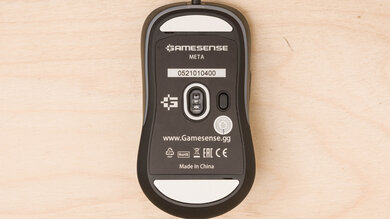The Gamesense Meta is a lightweight, ambidextrous mouse with two buttons on its left side and a dedicated CPI button behind its scroll wheel. It has low click latency, a very low lift-off distance, a wide CPI range, and a CPI that you can adjust in increments of 100. It's suitable for all grip types and most hand sizes; however, people with extra-large hands might find the mouse too small to hold comfortably with a palm or claw grip. Also, people with small hands may struggle to reach the scroll wheel when using a fingertip grip. It feels well-built, though the mouse rattles when shaken, and the scroll wheel wobbles side to side.
Our Verdict
The Gamesense Meta is decent for office and multimedia use. It feels well-built, and it's well-suited for any grip type for most hand sizes. Also, all its buttons are programmable within its customization software. Unfortunately, you can't use it wirelessly, and its scroll wheel lacks L/R tilt buttons and a free-scrolling mode.
-
All buttons are reprogrammable.
-
All default button functions work in Windows and macOS.
-
Wired-only.
-
Scroll wheel wobbles a little.
The Gamesense Meta is excellent for FPS gaming since the click latency is low, and the mouse is very light. Also, it feels well-built, and it's suitable for all grip types and most hand sizes. It has a flexible paracord-like cable and smooth-gliding mouse feet, and you can program all of its buttons. Performance-wise, it has a very low lift-off distance and a wide CPI range. You can adjust the CPI in increments of 100, but the adjustment steps aren't as precise as other gaming mice.
-
Low click latency.
-
Very low lift-off distance.
-
Very light.
-
All buttons are reprogrammable.
-
CPI is adjustable in increments of only 100.
-
Scroll wheel wobbles a little.
The Gamesense Meta is good for MMO gaming, but it doesn't have nearly as many side buttons as a dedicated MMO mouse. That said, you can program all the buttons it does have, and you can set a profile-switching button. It feels well-built, and it's suitable for all grip types and most hand sizes. Performance-wise, it has low click latency and a very low lift-off distance. You can adjust the CPI in increments of 100, but the adjustment steps aren't as precise as other gaming mice.
-
Low click latency.
-
Very low lift-off distance.
-
All buttons are reprogrammable.
-
CPI is adjustable in increments of only 100.
-
Scroll wheel wobbles a little.
The Gamesense Meta is an excellent ultra-light gaming mouse since it's very light. Also, it has low click latency, a flexible paracord-like cable, and smooth-gliding mouse feet. It feels well-built, and its ambidextrous design is suitable for all grip types and most hand sizes.
-
Low click latency.
-
Very low lift-off distance.
-
Very light.
-
All buttons are reprogrammable.
-
Scroll wheel wobbles a little.
The Gamesense Meta is disappointing for travel since it's a wired mouse. Its cable might get in the way when using the mouse in tight spaces, like buses, trains, or planes. That said, it feels well-built overall, and it's suitable for all grip types and most hand sizes. It has onboard memory, and all of its default button functions work in Windows and macOS.
-
All default button functions work in Windows and macOS.
-
Wired-only.
-
Bulky; may not fit in laptop cases.
- 7.1 Office/Multimedia
- 8.5 Video Games (FPS)
- 7.8 Video Games (MMO)
- 8.8 Ultra-Light Gaming
- 5.4 Travel
- Updated Nov 04, 2021: Review published.
- Updated Nov 01, 2021: Early access published.
- Updated Aug 16, 2021: Our testers have started testing this product.
- Updated Aug 13, 2021: The product has arrived in our lab, and our testers will start evaluating it soon.
- Updated Aug 05, 2021: We've purchased the product and are waiting for it to arrive in our lab.
Differences Between Sizes And Variants
The Gamesense Meta is available in black only, and there are no other variants. You can see our unit's label here.
Compared To Other Mice
The Gamesense Meta is an excellent lightweight wired gaming mouse. It has a similar but slightly smaller shape to the BenQ ZOWIE S2, and it has RGB lighting in its palm logo and as a strip around its base. It has low click latency compared to many models in its price range, but you can't adjust its CPI as precisely as you can on other options. Nonetheless, if you're looking for a lightweight gaming mouse with good performance and plenty of sensor customization, it's an amazing option.
See our recommendations for the best gaming mice, the best wired mice, and the best lightweight mice.
The Gamesense Meta performs better overall than the Pwnage Ultra Custom Wireless Symm. The Gamesense is lighter, and it has much lower click latency. Also, you can program more inputs, and you can set a profile-switching button. On the other hand, the Pwnage has a honeycomb cutout design over its sides and palm rest, and it comes with a solid palm cover to customize the look and feel of the mouse. You can use it wirelessly via its USB receiver.
The HyperX Pulsefire Haste and the Gamesense Meta are both wired gaming mice. The HyperX has a honeycomb cutout pattern over its body, and it's a bit lighter. It feels better built, and its mouse feet glide smoother thanks to its rounded edges. Comparatively, the Gamesense has more programmable buttons and marginally lower click latency. If you have extra-large hands, you may prefer the HyperX's slightly larger size.
The Razer Viper Ultimate is an amazing wireless gaming mouse, while the Gamesense Meta is an excellent wired gaming mouse. You can use the Razer either wirelessly via its USB receiver or wired with its cable. It has smoother-gliding mouse feet, more programmable buttons thanks to its Hypershift feature, and slightly lower click latency. Also, it has a wider CPI range, and you can adjust its CPI more precisely. On the other hand, the Gamesense is lighter.
The Gamesense Meta and the BenQ ZOWIE S2 have a similar ambidextrous shape, but the Gamesense performs better overall. The Gamesense is much lighter, and it has a more flexible paracord-like cable and better quality mouse feet. Also, it has a lower lift-off distance, programmable buttons, and you can adjust the CPI in increments of 100, thanks to its customization software. On the other hand, the BenQ doesn't have software, and you can only cycle between four CPI preset settings. However, some people may prefer the BenQ's more straightforward design, with no RGB lighting or software.
The Gamesense Meta and the GLORIOUS Model O are both lightweight wired gaming mice. The Gamesense has more programmable inputs, and you can set a profile-switching button. Also, it has marginally lower click latency. On the other hand, the GLORIOUS has a more flexible cable and smoother-gliding mouse feet. Also, there are honeycomb cutouts on its top and underside.
The GLORIOUS Model D and the Gamesense Meta are both excellent wired gaming mice with a similar weight. The GLORIOUS has a honeycomb cutout design on its palm rest and L/R click buttons, and it has a more flexible cable and smoother-gliding mouse feet. On the other hand, the Gamesense feels better built, and it has more programmable buttons. Also, it has a lower minimum CPI and a lower lift-off distance. The Game sense is better suited for small hands using a claw grip, while the GLORIOUS is better for extra-large hands using a palm or claw grip.
The Gamesense Meta and the Razer DeathAdder V2 are excellent wired gaming mice, but the Razer performs better overall. The Razer has lower click latency, a more precisely adjustable CPI, and smoother-gliding mouse feet. Also, there are more programmable inputs, thanks to its Hypershift feature that enables a second layer of commands. On the other hand, the Gamesense is much lighter, and it has a paracord-like cable that's more flexible than the Razer's braided cable.
The Gamesense Meta is overall better for gaming than the EVGA X20. The Gamesense is much lighter, and it has a better quality and more flexible cable. Its mouse feet are also better quality and glide much smoother. It has a lower lift-off distance and lower click latency. That said, the EVGA has a wider CPI range with a more precisely adjustable CPI. Also, it has more programmable buttons, and you can use it wirelessly via its USB receiver or Bluetooth.
Test Results
The polling rate options available on the Gamesense Meta are 125Hz, 500Hz, and 1000Hz. You can set seven CPI settings to cycle through with the button behind the scroll wheel.
You can reprogram all buttons on the Gamesense Meta, including the button on the underside, which cycles through RGB effects by default.
You can use the GSMeta software to customize the CPI, polling rate, lift-off distance, debounce time, and RGB lighting. Also, you can reprogram buttons, set macros, create up to five profiles, and save the profiles to the onboard memory.













